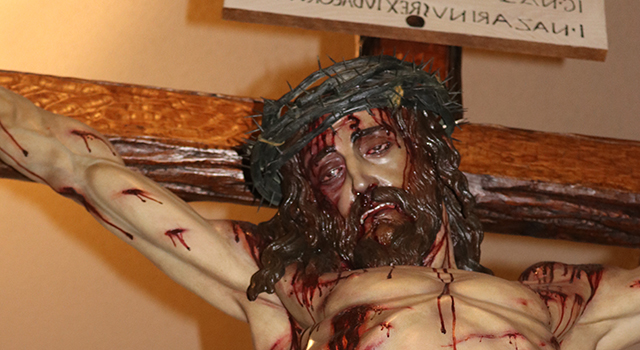By Rocio Granados - La Voz Catolica
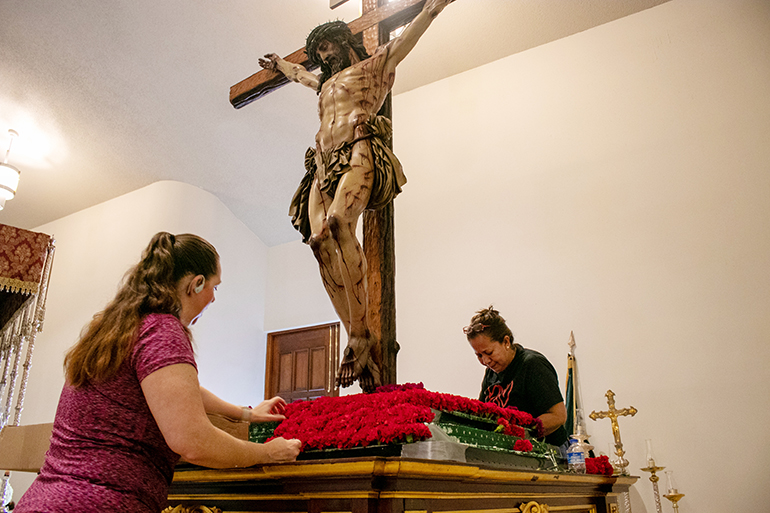
Photographer: ROCIO GRANADOS | LVC
Volunteers from Corpus Christi Parish in Miami decorate the platform of the Cristo de la Misericordia (Christ of Mercy) for the Good Friday procession on April 15, 2022. The cedar sculpture made by Juan Manuel Miñarro is one of only two such pieces in the world.
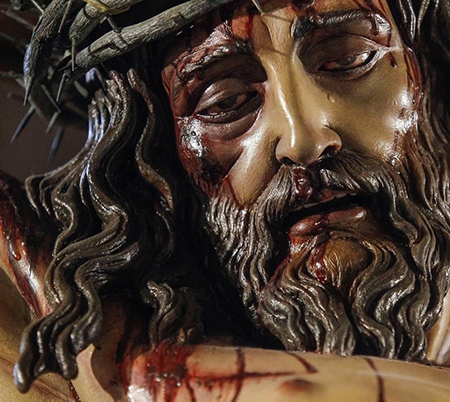
Photographer: Courtesy
Close-up of the face of the Cristo de la Misericordia (Christ of Mercy), a sculpture carved in cedar by Juan Manuel Miñarro. It is one of only two pieces in the world and vividly reproduces the injuries and wounds inflicted on Christ as revealed by the Shroud of Turin and the Sudarium of Oviedo. It was made for Corpus Christi Parish in Miami and taken out in procession for the first time on Good Friday 2022.
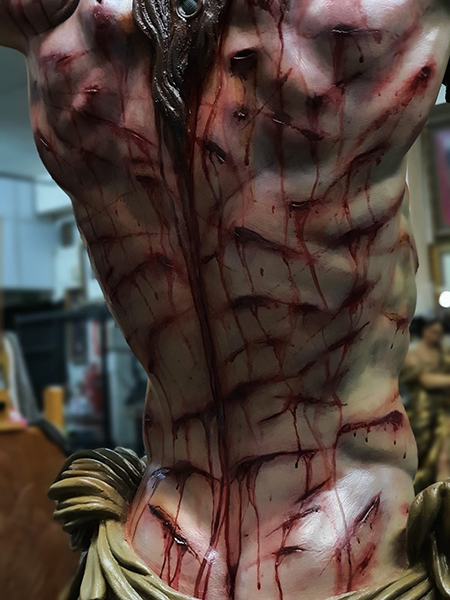
Photographer: Courtesy Fabin Sanchez
The back of the Cristo de la Misericordia (Christ of Mercy) depicts the blows visited upon Jesus during the flagellation described in the Gospels. The sculpture has about 500 wounds on the front and back. Sculptor Juan Manuel Miñarro wanted to represent in a realistic way how Jesus looked during the last hours of his passion. The image, carved in cedar wood, is housed at Corpus Christi Parish in Miami.
MIAMI | On Good Friday, parishioners of Corpus Christi Church in Miami will again reflect on Jesus' Passion while processing the streets alongside the sculpture of Cristo de la Misericordia (Christ of Mercy), the only sculpture of its kind in the world.
This life-size and realistic image of Jesus Christ crucified during his last hours of the Passion was carved in cedar by renowned Spanish sculptor Juan Manuel Miñarro, a scholar of the Shroud of Turin and the Sudarium of Oviedo. It is the first sculpture to present the body completely pierced by the lance, as told in the Gospel of St. John.
The Christ of Mercy "is the man of the Holy Shroud; this is him," said Father José Luis Menéndez, Corpus Christi's pastor.
The sculpture of Christ "has about 500 wounds on the front and back. It captures that pain, shown by his sweaty face, his fractured nose and his left cheekbone swollen from the blows," explained Fabian Sanchez, a member of the parish's Brotherhood of the Virgin of the Macarena and the liaison between the parish and the sculptor.
In 2018, Corpus Christi was looking for an image "that represented in realistic terms the Passion of Christ," Sánchez told La Voz Católica, the Spanish language newspaper of the Archdiocese of Miami.
They found the Crucified Christ image at a university in Cordoba, Spain, made by Miñarro in 2010 based on the studies of the Shroud of Turin. They asked the sculptor for a replica, but Miñarro — who is part of the research team of the Spanish Center of Sindonology and the International Center of Studies of the Shroud of Turin — offered to make a unique image for the parish also based on the shroud, but with the most recent knowledge about crucifixions in Roman times.
The artist managed to capture a Christ that may have been dead for one to two hours. The eyes are not fully closed and remain glassy, with a wounded look. "They are eyes that reveal to us that there is no longer life in that body. It is represented in mortal plenitude, which has not yet been affected by rigor mortis," Miñarro said in a video on the parish website.
Scientific studies of anatomy, criminology, and forensic medicine made on the Shroud of Turin show mistreatment in different parts of the body, a crown of thorns that caused wounds around the perimeter of his head and systematic flagellation.
"Those wounds are there. The shroud describes it perfectly," said Miñarro.
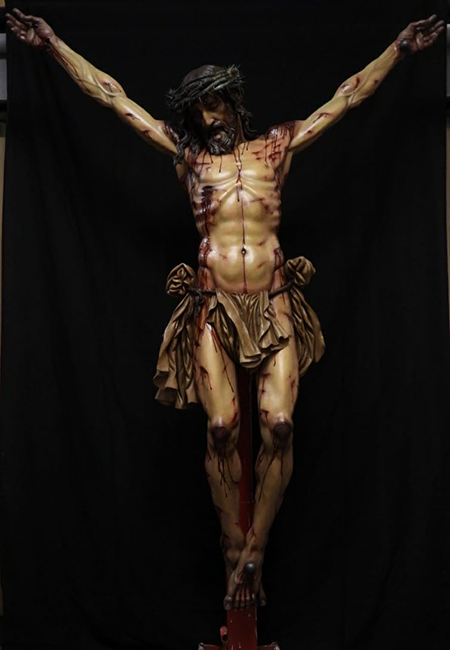
Photographer: Courtesy
The Cristo de la Misericordia (Christ of Mercy) is a life-size sculpture of Jesus Christ crucified, depicting the last hours of his passion, and carved in cedar. It was made for Corpus Christi Parish in Miami by the renowned Sevillian sculptor Juan Manuel Miñarro, a scholar of the Shroud of Turin and the Sudarium of Oviedo.
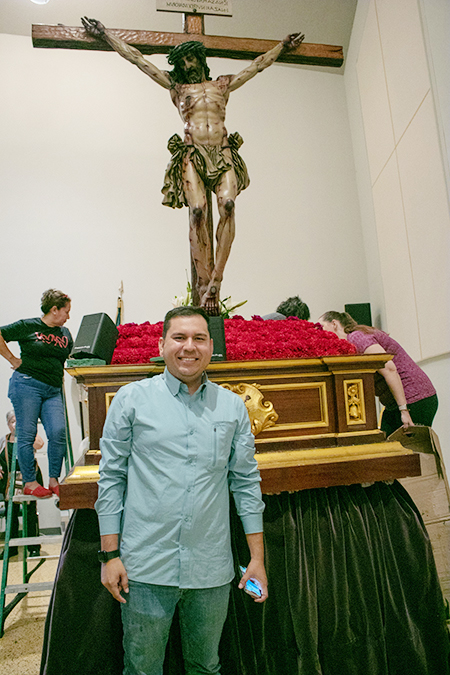
Photographer: ROCIO GRANADOS | LVC
Fabian Sanchez, a member of Corpus Christi Parish's Brotherhood of the Virgin of the Macarena, poses with the image of the Cristo de la Misericordia (Christ of Mercy) as it was decorated to be taken out in procession on Good Friday 2022. Sanchez was the liaison between the parish and the image's sculptor, Juan Manuel Miñarro.
The shroud's study is based on "the stains of these wounds in the fabric are produced by contact and absorption," explained Miñarro. More recent studies revealed that nails were used for the wrists, not the palms of the hands. It has not been possible to determine if one nail was used for both feet, or a nail for each foot.
"With those wounds, with those lacerations on the face, that fall of the body on the cross, which (is known) through the forensic studies done with corpses and with anatomical models hung on a cross, there is no doubt that his wound, the one on his side, is incompatible with life", Miñarro said. "It is the first of my Crucified (images) and the first probably in the world to have that spear wound."
In addition to having several more flogging marks and wounds than usually represented in Christ sculptures, people can also see that the left shoulder is dislocated, as shown by a 3D reconstruction of the body of the shroud.
To make the sculpture Miñarro made clay molds and spent several months looking for the correct position of a human body on the cross, such as the arms hanging down and the knees that no longer support the weight of a dying body. He also placed sand from Jerusalem on the knees, porous from multiple falls.
In addition to the Cristo de la Misericordia and the Christ in Cordoba, Miñarro has made several religious sculptures, including images of the Virgin Mary and Jesus Christ, which have been exhibited in different parts of the world, such as the Nazareno de la Humildad (the Nazarene of humility).
The Christ of Mercy is about 5 feet 6 inches tall and is attached to a six-foot-tall cross. It was due to arrive in Miami in late 2020 but, due to the COVID pandemic, the Christ arrived in late 2021.
Before arriving, it was part of several exhibitions in Seville during Holy Week 2021. It was exhibited in the cathedral and in the Seville City Hall where the image was known as the Christ of Great Delivery. When it arrived in Miami, it was renamed Christ of Mercy.
"Because it is perhaps what our society needs most today, mercy," Father Menendez said.
He highlighted three great tragedies today: the remnants of the coronavirus pandemic, the growing migration, and the war in Ukraine, which affects the whole world.
With this image, "I would like people to see the stark reality of God's great love for us. The ability to give us his own Son so that we would do this to him," Father Menendez said, adding, "If you see God's love in him, then you can have confidence in asking for mercy."
The Christ of Mercy is on display throughout the year in the Blessed Sacrament chapel of Corpus Christi Church. It will go out in procession for the second time on Good Friday, April 7, at 9 p.m., going from the church through the Wynwood neighborhood, north of downtown Miami, along with the Virgen de la Esperanza Macarena (Macarena Virgin of Hope), a replica of the one from Seville.
Inspired by the Spanish tradition, Corpus Christi’s Good Friday procession stands out for its colorful “carpets,” the impressive images of Jesus and Mary brought from Spain, the attire of the members of the Brotherhood of Hope of the Macarena, and the singing of saetas, or sacred songs.
To learn more about the image of the Christ of Mercy and the Holy Week events at Corpus Christi Parish in Miami, visit: www.corpuschristimiami.org.
